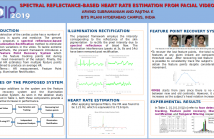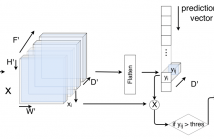- Image/Video Storage, Retrieval
- Image/Video Processing
- Image/Video Coding
- Image Scanning, Display, and Printing
- Image Formation

- Read more about SPECTRAL REFLECTANCE BASED HEART RATE MEASUREMENT FROM FACIAL VIDEO
- Log in to post comments
Remote detection of the cardiac pulse has a number of applications in sports and medicine, and can be used to determine an individual’s physiological state. Previous approaches to estimate Heart Rate (HR) from video require the subject to remain stationary and employ background information to eliminate illumination interferences. The present research proposes a spectral reflectance-based novel illumination rectification method to eliminate illumination variations in the video.
- Categories:
 53 Views
53 Views
- Read more about SALIENCY TUBES: VISUAL EXPLANATIONS FOR SPATIO-TEMPORAL CONVOLUTIONS
- Log in to post comments
Deep learning approaches have been established as the main methodology for video classification and recognition. Recently, 3-dimensional convolutions have been used to achieve state-of-the-art performance in many challenging video datasets. Because of the high level of complexity of these methods, as the convolution operations are also extended to an additional dimension in order to extract features from it as well, providing a visualization for the signals that the network interpret as informative, is a challenging task.
- Categories:
 28 Views
28 Views
- Read more about End-To-End Visual Place Recognition Based on Deep Metric Learning and Self-Adaptively Enhanced Similarity Metric
- Log in to post comments
- Categories:
 28 Views
28 Views

- Read more about RAIN STREAKS REMOVAL FOR SINGLE IMAGE VIA DIRECTIONAL TOTAL VARIATION REGULARIZATION
- Log in to post comments
- Categories:
 19 Views
19 Views
- Read more about Glidar3DJ: A VIEW-INVARIANT GAIT IDENTIFICATION VIA FLASH LIDAR DATA CORRECTION
- Log in to post comments
Gait recognition is a leading remote-based identification method, suitable for applications in forensic cases, surveillance, and medical studies. We present Glidar3DJ, a model-based gait recognition methodology, using a skeleton model extracted from sequences generated by a single flash lidar camera. Compared with Kinect, a flash lidar camera has a drastically extended range (> 1000 meters) and its performance is not affected in outdoor.
- Categories:
 74 Views
74 Views
- Read more about LCUTS: LINEAR CLUSTERING OF BACTERIA USING RECURSIVE GRAPH CUTS
- Log in to post comments
Bacterial segmentation poses significant challenges due to
lack of structure, poor imaging resolution, limited contrast
between touching cells and high density of cells that overlap.
Although there exist bacterial segmentation algorithms in the
existing art, they fail to delineate cells in dense biofilms,
especially in 3D imaging scenarios in which the cells are growing
and subdividing in an unstructured manner. A graph-based
- Categories:
 17 Views
17 Views
- Read more about MOTION SALIENCY BASED GENERATIVE ADVERSARIAL NETWORK FOR UNDERWATER MOVING OBJECT SEGMENTATION
- Log in to post comments
The underwater moving object segmentation is a challenging task. The problems like absorbing, scattering and attenuation of light rays between the scene and the imaging platform degrades the visibility of image or video frames. Also, the back-scattering of light rays further increases the problem of underwater video analysis, because the light rays interact with underwater particles and scattered back to the sensor. In this paper, a novel Motion Saliency Based Generative Adversarial Network (GAN) for Underwater Moving Object Segmentation (MOS) is proposed.
- Categories:
 24 Views
24 Views
- Read more about MOTION SALIENCY BASED GENERATIVE ADVERSARIAL NETWORK FOR UNDERWATER MOVING OBJECT SEGMENTATION
- Log in to post comments
The underwater moving object segmentation is a challenging task. The problems like absorbing, scattering and attenuation of light rays between the scene and the imaging platform degrades the visibility of image or video frames. Also, the back-scattering of light rays further increases the problem of underwater video analysis, because the light rays interact with underwater particles and scattered back to the sensor. In this paper, a novel Motion Saliency Based Generative Adversarial Network (GAN) for Underwater Moving Object Segmentation (MOS) is proposed.
Poster.pdf
- Categories:
 13 Views
13 Views
- Read more about MOTION SALIENCY BASED GENERATIVE ADVERSARIAL NETWORK FOR UNDERWATER MOVING OBJECT SEGMENTATION
- Log in to post comments
The underwater moving object segmentation is a challenging task. The problems like absorbing, scattering and attenuation of light rays between the scene and the imaging platform degrades the visibility of image or video frames. Also, the back-scattering of light rays further increases the problem of underwater video analysis, because the light rays interact with underwater particles and scattered back to the sensor. In this paper, a novel Motion Saliency Based Generative Adversarial Network (GAN) for Underwater Moving Object Segmentation (MOS) is proposed.
Poster.pdf
- Categories:
 41 Views
41 Views